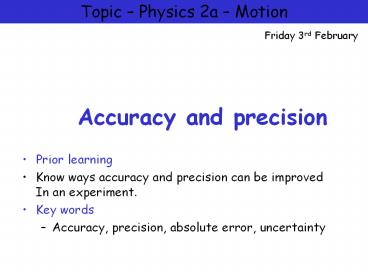Accuracy and precision - PowerPoint PPT Presentation
Title:
Accuracy and precision
Description:
Topic Physics 2a Motion Friday 3rd February Accuracy and precision Prior learning Know ways accuracy and precision can be improved In an experiment. – PowerPoint PPT presentation
Number of Views:445
Avg rating:3.0/5.0
Title: Accuracy and precision
1
Accuracy and precision
Topic Physics 2a Motion
Friday 3rd February
- Prior learning
- Know ways accuracy and precision can be improved
In an experiment. - Key words
- Accuracy, precision, absolute error, uncertainty
2
Starter task Recap standard measurements /
Scientific notation
Heinemann Questions 1.1 1-5 page 41
3
Topic Physics 2a
By the end of this lesson we should be able to
- Define terms accuracy, precision, uncertainty and
absolute error - Use uncertainty of common lab equipment to
calculate measurement with uncertainty - Estinate the uncertainty of a result using an
experiment
4
Task 1 notes
- Accuracy relates to an instruments use.
- An instrument is accurate if it truly reflects
the quantity being measured e.g. if you wanted to
measure the width of this page you would use a
ruler with millimetre markings. - Precision relates to how an instrument
differentiates between slightly different
quantities e.g. bathroom scales, kitchen scales
and laboratory scales all measure mass and are
accurate for the mass they measure. - Laboratory scales are more precise as they can
measure to 0.01 g whereas bathroom scales can
measure to 0.5 kg
5
Task 1 notes
- Uncertainty
- All measurements you make have some amount of
uncertainty. - The uncertainty of an instrument is usually one
half of the finest scale e.g. a ruler which
measures in millimetres has an uncertainty of 0.5
mm. An electronic timer usually to ?0.005 s - The uncertainty of an instrument measure its
precision. If you measure the width of an A4
piece of paper you will get a reading of 21.1 cm.
The uncertainty is 0.5 mm so the reading is 21.1
? 0.05 cm
6
Uncertainty in common laboratory equipment
- Metre rule ? 0.05 cm
- 50 mL measuring cylinder ? 0.2 mL
- 50 mL measuring cylinder ? 0.2 mL
- 10 mL measuring cylinder ? 0.1 mL
- -100C 1100C thermometer ? 0.50C (does depend
on precision of thermometer)
7
Task 2 Activity
- Use a timer, ruler, thermometer and measuring
cylinder to take some measurements including the
uncertainty in each measurement.
8
Estimating the uncertainty in a result
- An experiment or a measurement exercise is not
complete until the uncertainties have been
analysed. The report should include an estimate
of the total uncertainty. This gives the reader
of the report some idea of your confidence in the
result. - The following processes are used for estimating
uncertainty. - When adding or subtracting data, add the absolute
uncertainties. - e.g. ?T (change in temperature) 40 ? 0.5 0C
- 35 ? 0.5 0C 5 ? 1 0C - When multiplying or dividing data, add the
percentage uncertainties.
9
Absolute and uncertainty
10
- You would calculate as follows
- Specific heat of metal to a whole number so
answer so far is cmetal 198 J kg-1 K-1 - Uncertainty () 0.120 0.6 23 0.476
1.351 25.547 - Hence, you would obtain the following result
cmetal 198 Jkg-1J-1 ?
25.547 - now 25.547 of 198 50.6
- so cmetal 198 ? 51 Jkg-1J-1
- Once you have done all of this you can consider
the relative success of your measurement
exercise. - Your result is 147 J kg1 K1 ? cmetal
? 249 J kg1 K1
11
- If I then give you the actual specific heat of
the metal and it falls within your values, you
can conclude that your experiment is consistent
with known values (accurate). Or in other words,
there are probably no major errors.
12
Summary task
- Read pg 43/44
- Work through example 1.2A
- Then questions from text pg.45
- Check answers in the back of book
- Ask for help!!
13
Topic Physics 2a
By the end of this lesson we should be able to
- Define terms accuracy, precision, uncertainty and
absolute error - Use uncertainty of common lab equipment to
calculate measurement with uncertainty - Estimate the uncertainty of a result using an
experiment































